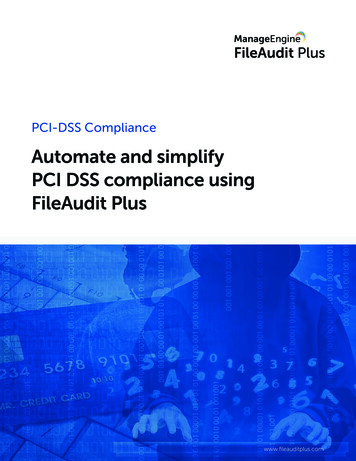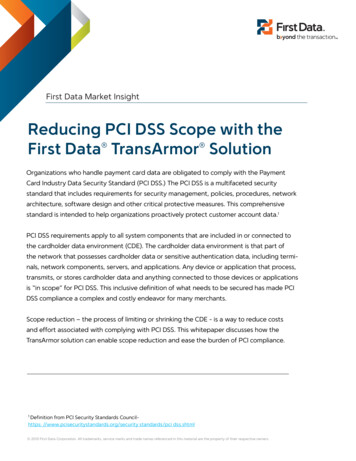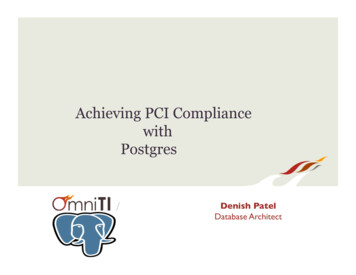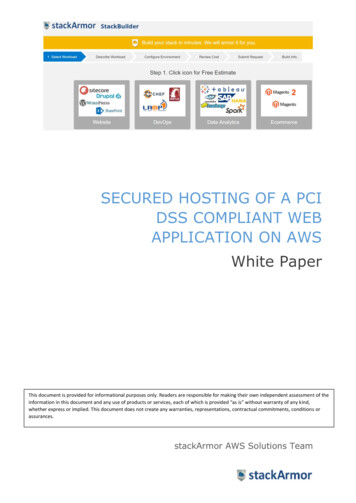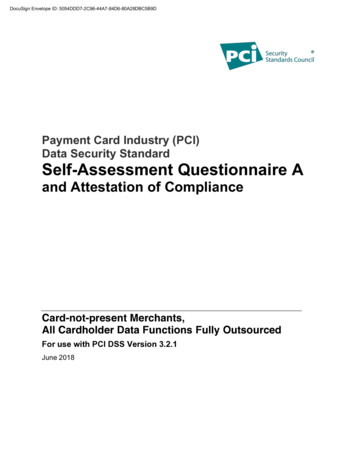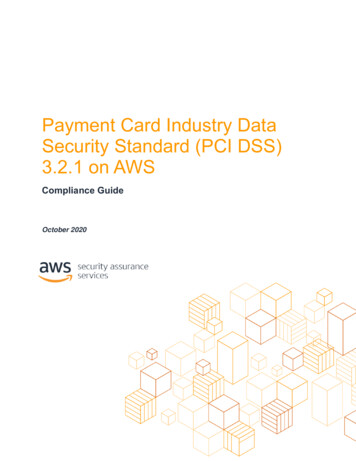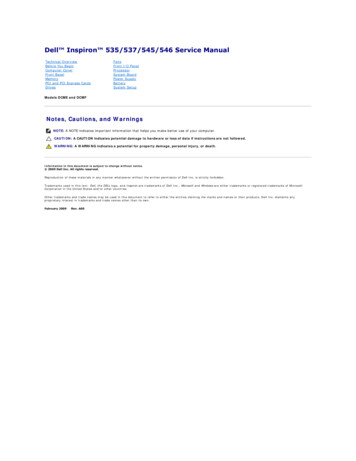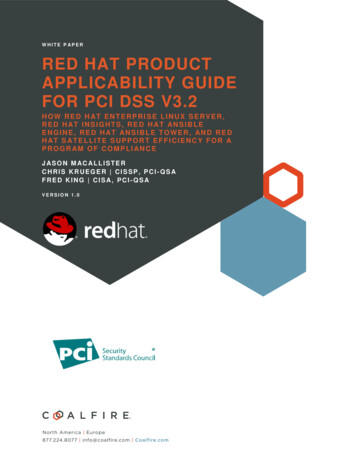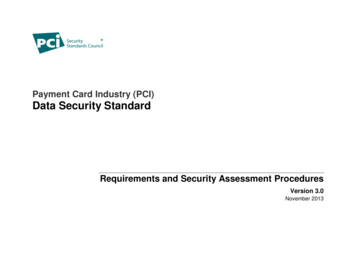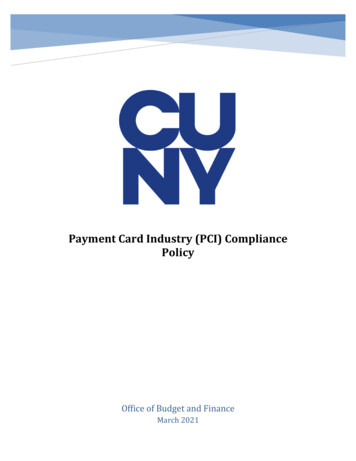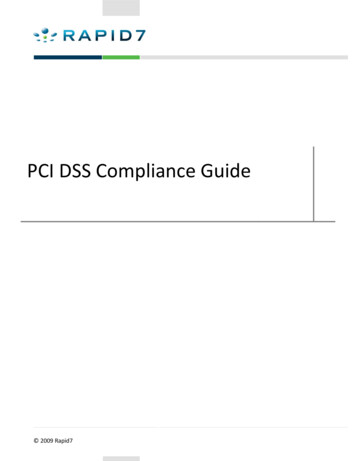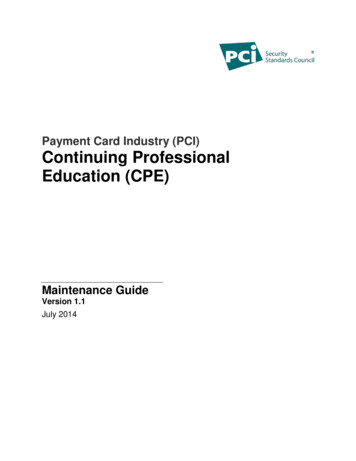
Transcription
Payment Card Industry (PCI)Continuing ProfessionalEducation (CPE)Maintenance GuideVersion 1.1July 2014
Document ChangesDateVersionDescriptionMay 20141.0CPE Maintenance Guide v1.0, this is the first release of the CPEMaintenance Guide.July 20141.1Change the PCIP CPE hours requirement from none to 10 per year.CPE Maintenance Guide, v1.1 2014 PCI Security Standards Council, LLCJuly 2014Page i
Table of ContentsDocument Changes . i1Introduction . 11.12Approved Methods for Obtaining CPE Credit . 32.12.22.32.42.53PCI SSC Activities . 3Other Qualified Training Activities . 4Qualified Teaching Activities . 5Lecturing and Other Presentations . 6Publication of Articles and Other Literature . 6Obtaining and Reporting CPE Credits . 73.13.24Terminology . 2Retention . 7Impact on Annual Requalification . 7CPE Credit Review, Approval, and Dispute Resolution . 84.1Outcome of Failure to Comply with CPE Guidelines . 8CPE Maintenance Guide, v1.1 2014 PCI Security Standards Council, LLCJuly 2014Page ii
1 IntroductionContinuing professional education is an important component of managing your PCI SSC Qualification. On an on-going basis, staying up-to-dateand current with the latest knowledge, techniques, and insights helps support the PCI Program Participant’s ability to effectively conduct the tasksand responsibilities associated with the Program Participant’s PCI SSC Qualification. The purpose of this guide is to document the process forreporting of Continuing Professional Education (CPE) credits to PCI SSC.CPE Maintenance Guide, v1.1 2014 PCI Security Standards Council, LLCJuly 2014Page 1
1.1 TerminologyThroughout this document, the terms listed below shall have the meanings shown.TermMeaningContinuing ProfessionalEducation (CPE) CreditA unit of professional development obtained by the Program Participantand reported to PCI SSC to demonstrate the ongoing continuingeducation and professional development activities of the ProgramParticipant.CPE CycleProgram-specific number of CPEs to be obtained and reported over adefined period of time; may differ by Qualification Program. For example,QSA employees must obtain 120 CPEs over a rolling three-year periodwith a minimum of 20 CPEs per year.PCI PortalDatabase used for keeping records of CPE credits and hours, companyinformation, and Program Participant data.Primary ContactThe assigned or designated employee contact on file with PCI SSC forthe Program Participant’s company or employer for the applicableQualification Program. One Primary Contact is designated per companyper Qualification Program.Program ParticipantAn individual who has been qualified by PCI SSC under, and satisfiesand continues to satisfy all applicable qualification and requalificationrequirements for a given Qualification Program (e.g. a PCI SSC-qualifiedQSA Employee, QIR Employee, ASV Employee, or PCIP Employee).QualificationThe individual qualification earned by an individual who successfullycompletes all required PCI SSC training and training exams, and adheresto corresponding qualification and requalification requirements under aQualification Program (e.g. a PCI SSC-qualified QSA Employee, QIREmployee, ASV Employee, or PCIP Employee).Qualification ProgramA program developed and managed by PCI SSC under which companiesand/or individuals may receive a corresponding PCI SSC qualification(e.g. QSA, ASV, QIR and PCIP) subject to application submission,successful completion of required PCI SSC training and training exams,and adherence to corresponding program qualification and requalificationrequirements, including but not limited to CPE attainment and recording.WebsiteThe then current PCI SSC website (and its accompanying Web pages),which is currently available at www.pcisecuritystandards.org.CPE Maintenance Guide, v1.1 2014 PCI Security Standards Council, LLCJuly 2014Page 2
2 Approved Methods for Obtaining CPE CreditA PCI Program Participant may obtain approved CPE credits using one or more of the following methods.Please note that, in general, CPE credits are not earned for day-to-day activities performed as part of anindividual’s employment.2.1 PCI SSC ActivitiesThe PCI SSC provides several opportunities directly to Program Participants for obtaining CPE credit.Activities include: Attendance at and participation in conferences presented by the PCI SSC, such as annualCommunity Meetings and Assessor sessions. Completion of a new or re-qualifying PCI SSC training course. Attending webinars presented by the PCI SSC that support learning and development for a PCIQualification and identified as valid for CPE credit by the PCI SSC. Special Interest Group (SIG) involvement and similar activities, such as providing feedback whenrequested by PCI SSC during a formal Open Feedback period (maximum of 5 CPE creditsannually, 15 CPE credits per rolling three-year cycle). Any additional activities as determined and communicated as eligible for CPE credit attainment.A PCI Program Participant can earn CPE credit according to the number of hours of active participation.The Program Participant is responsible for retaining evidence of their attendance and participation andshould not rely on PCI SSC to retain this information on their behalf. While there are annual CPEminimum requirements by PCI Qualification Program, there is no annual CPE maximum limit. PCI SSCQualification Program CPE requirements are as follows (as of May 2014):Table 1: PCI SSC CPE Credit Requirements by Qualification ProgramProgramCPE Credit RequirementsCommentsASVMinimum of 20 CPE credits/year,minimum of 120 CPE credits perrolling 3-year periodISAThere is no requirement to submitevidence of CPE creditsRecommendation: Adhere to CPErequirements established for QSAsPA-QSABased on QSA CPE requirementsNo additional CPE credits required aboveand beyond the CPE credit requirementsestablished for the QSA programPCIPMinimum of 10 CPE credits/year,minimum of 30 CPE credits per 3year re-qualification periodPFIBased on QSA CPE requirementsQIRThere is no requirement to submitevidence of CPE creditsCPE Maintenance Guide, v1.1 2014 PCI Security Standards Council, LLCNo additional CPE credits required aboveand beyond the CPE credit requirementsestablished for the QSA programJuly 2014Page 3
ProgramCPE Credit RequirementsQSAMinimum of 20 CPE credits/year,minimum of 120 CPE credits perrolling 3-year periodQSA (P2PE) andPA-QSA (P2PE)Based on QSA CPE requirementsCommentsNo additional CPE credits required aboveand beyond the CPE credit requirementsestablished for the QSA programPCI SSC may, from time to time modify CPE requirements by Qualification Program and this will becommunicated to the impacted Qualification Program practitioner in advance.2.2 Other Qualified Training ActivitiesThere are many additional activities that may help to satisfy PCI SSC CPE credit requirements. AProgram Participant may: Attend industry conferences. Attend chapter meetings. Participate in relevant company training. Attend university courses (maximum of 10 CPE credits per semester/term course). Attend seminars, workshops, and other forms of relevant meetings. Submit, and have published, articles to PCI SSC newsletters. Receive additional professional certifications such as the CISSP, CISA, and CISM (maximum of10 CPE credits per certificate). Subscribe to and read books and information security periodicals (maximum of 5 CPE creditsannually). Engage in other forms of self-learning.The intent is to demonstrate continued, active exploration of new threats and vulnerabilities and thetechnology and methodology to mitigate such risks. Unless otherwise stated, there is no annual CPEmaximum limit for participation in these activities. A Program Participant may receive CPE credit fortechnology-specific educational activities (e.g., an operating systems class, software developmentseminar, etc.) so they are better prepared to perform a security assessment. A maximum of 15 CPEcredits per cycle for non-security related, technology-specific, or audit-focused training may besubmitted.CPE Maintenance Guide, v1.1 2014 PCI Security Standards Council, LLCJuly 2014Page 4
On-Site TrainingFor on-site training, each hour of in-class lecture may account for one CPE credit. Please note that CPEcredits must always be rounded down.For example, a training class that is scheduled from 8:00am – 5:00pm would most likely account for 9hours or 7 CPE credits as there is an assumed one-hour lunch break and two 15-minute breaks.Table 2. On-Site Training CPE Credit BreakdownActivityBeginsEndsCPE CreditClass Instruction8:00am10:00am2Break10:00am10:15am0Class Instruction10:15am12:15pm2Lunch12:15pm1:15pm0Class Instruction1:15pm3:15pm2Break3:15pm3:30pm0Class ible CPE credit (rounded down for reporting to PCI SSC):72.3 Qualified Teaching ActivitiesThe PCI SSC recognizes the effort to create a presentation or author an article and the amount ofresearch often required. A Program Participant may submit teaching activities up to a maximum of 20CPE credits annually. Please note that all presentations should be related to protecting cardholderinformation and not include sales or marketing presentations on behalf of the company. For example, apresentation to industry peers on effective firewall configurations would qualify for CPE credit, but apresentation on how a company’s product meets PCI requirements would not qualify.CPE Maintenance Guide, v1.1 2014 PCI Security Standards Council, LLCJuly 2014Page 5
2.4 Lecturing and Other PresentationsA Program Participant can receive credit as an instructor or guest speaker for the development and thedelivery of a presentation relevant to safeguarding sensitive information. A Program Participant cannotreceive additional CPE credit for the same lecture after the material has been presented to threedifferent audiences unless the content has been significantly modified. CPE credit can be earned at themaximum rate of two hours of preparation for each single hour of delivery.Table 3. Example of CPE credits to be obtained for lectures and other presentationsPresentationLength ofPresentationHours of PreparationCPE Creditst2 hours2 hours4nd2 hours0 hours2rd2 hours0 hours2th2 hours0 hours0st1 hour3 hours (maximum of 2 credited hours)3Total Eligible CPE credit:11Lecture 1 – 1 AudienceLecture 1 – 2 AudienceLecture 1 – 3 AudienceLecture 1 – 4 AudienceLecture 2 – 1 Audience2.5 Publication of Articles and Other LiteratureAuthoring an article for a formal publication, website, or other medium that is relevant to informationsecurity systems and practices is eligible for CPE credit. The publication or website must be recognizedas media commonly read by industry peers. CPE hours will be credited for the hours required toresearch the article or publication (up to a maximum of 5 hours) and up to 1 CPE credit for every pageof content or 1 CPE credit for each article published in a PCI SSC newsletter. For example, a 7-pagedocument with 5 pages of content and more than 5 hours of research may account for 10 CPE credits.Table 4. Example of CPE credits to be obtained for publication and other literatureWriting ActivityActualRelevant ContentCPE CreditPages755Hours855Total Eligible CPE credit:10Note: Any published misinformation related to PCI Security Standards or supporting programs will bedisqualified from earning CPE credit and may lead to termination of the Program Participant’sQualification.CPE Maintenance Guide, v1.1 2014 PCI Security Standards Council, LLCJuly 2014Page 6
3 Obtaining and Reporting CPE CreditsThe Program Participant is responsible for: Completing the CPE requirements established in Table 1 above for each Qualification Programthey participate in. These hours must be appropriate to the maintenance or advancement of theProgram Participant’s knowledge or ability to perform tasks relevant to the PCI SSC standardsand/or their applicable Qualification Program. The use of these hours towards meeting the CPErequirements for multiple PCI Qualifications is permissible when the professional activity isapplicable towards satisfying the job-related knowledge of each Qualification. Reporting earned annual CPE credits to PCI SSC as instructed and responding to any and allinquiries including, but not limited to, proving CPE credits submitted. Responding and submitting required documentation of CPE activities if selected for an audit.The Program Participant, guided by the approved CPE attainment methods described above, must attain,successfully complete, and record all valid and applicable CPE credits. As requested by PCI SSC or atleast annually, Program Participants will be required to submit all earned CPE credits over the course ofthe prior twelve months via e-mail to PCI SSC for review and approval. In most cases, the ProgramParticipant will be required to first submit their earned CPE credits to their company’s primary PCI contactwho then submits, on their behalf, the CPE credit submission form directly to PCI SSC. A CPE creditsubmission form is available on the PCI SSC website to record and submit CPE activity.3.1 RetentionProof of CPE credit attainment must be retained for 12 months following submission to, and acceptanceby, PCI SSC. Documentation should be in the form of a letter, certificate of completion, attendanceroster, Verification of Attendance form, or other independent attestation of completion. At a minimum,each record should include the name of the attendee, name of the sponsoring organization, activity title,activity description (including hours), activity date, and the number of CPE credit hours awarded orclaimed.3.2 Impact on Annual RequalificationIf the Program Participant’s CPE credit hours meet the minimum yearly and rolling three-year minimumrequirements, the Program Participant or primary contact will then be eligible to enroll the ProgramParticipant in the appropriate requalification training class (if applicable).Once the Program Participant has successfully completed their requalification training (if applicable) andexam, an electronic certificate will be provided via e-mail and the Program Participant’s active status onthe PCI SSC website will be updated to reflect the new Qualification expiration date (if applicable).CPE Maintenance Guide, v1.1 2014 PCI Security Standards Council, LLCJuly 2014Page 7
4 CPE Credit Review, Approval, and Dispute ResolutionPCI SSC will review all submitted CPE credits and may, from time to time, question a Primary Contact, orin their absence, the Program Participant regarding the validity of a CPE credit submitted. The PrimaryContact or Program Participant must then submit supporting evidence and documentation of the reportedCPE credit hours to PCI SSC through the PCI Portal or e-mail, as applicable, prior to the ProgramParticipant’s Qualification expiration date. PCI SSC will review the submitted documentation anddetermine the number of approved CPE credits to be accepted.In the case of approval, PCI SSC will send an e-mail to the Primary Contact or, in their absence, theProgram Participant notifying him or her that the Program Participant’s CPE credits have been accepted.In the case of failure, PCI SSC will send an e-mail to the Primary Contact or Program Participant notifyinghim or her that the Program Participant has not submitted acceptable supporting evidence ordocumentation. In this notification, PCI SSC will include the reason(s) for failure, which could include: Reporting more than permitted credit for CPE hours earned unrelated to PCI or IT Security. Reporting hours not earned during the accumulation timeframe. No evidence of supporting documentation or proof of attendance.Failure to meet the minimum annual CPE credit requirement for a given Qualification Program may resultin Remediation or revocation of a Program Participant’s Qualification(s).4.1 Outcome of Failure to Comply with CPE GuidelinesProgram Participants who fail to comply with the PCI SSC policy of obtaining and managing their CPEcredits or fail an audit of submitted CPE credits may have their PCI SSC Qualification(s) revoked.Program Participants who have their PCI SSC Qualification(s) revoked and wish to become active againmay be required to successfully complete new Qualification training and/or training exam(s), unless theysuccessfully apply for reconsideration within fifteen (15) days of audit failure notification and prevail onappeal). Program Participants should consult the applicable PCI SSC Qualification Requirementsdocument for further guidance on managing PCI SSC Qualifications.Program Participants whose Qualification has been revoked due to non-compliance with the CPE policyand who appeal for reinstatement within 15 business days may incur an additional reinstatement fee.CPE Maintenance Guide, v1.1 2014 PCI Security Standards Council, LLCJuly 2014Page 8
of content or 1 CPE credit for each article published in a PCI SSC newsletter. For example, a 7-page document with 5 pages of content and more than 5 hours of research may account for 10 CPE credits. Table 4. Example of CPE credits to be obtained for publication and other literature . Writing Activity Actual Relevant Content CPE Credit
